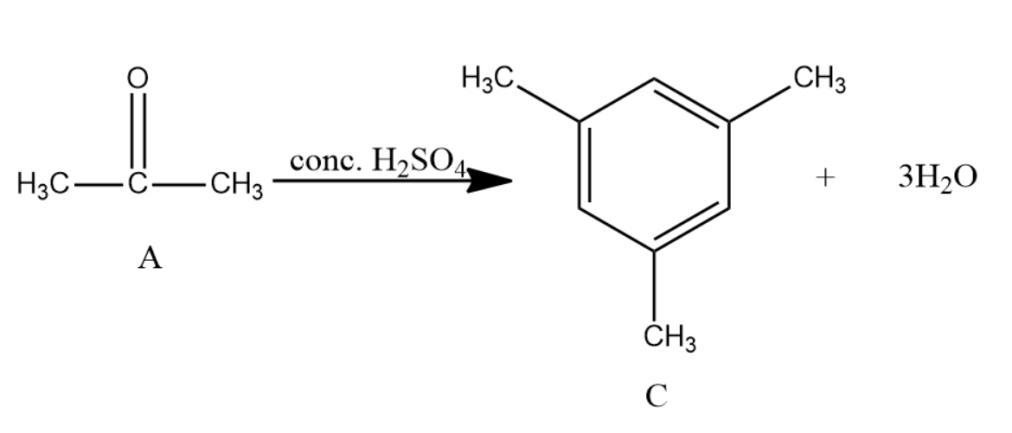
Answer
461.7k+ views
Hint: Clemmensen reduction is a chemical reaction for the reduction of ketones or aldehydes to alkanes using zinc amalgam and concentrated HCl. Fehling’s solution besides Tollen’s reagent is used to differentiate between reducing and non reducing sugars.
Complete answer:
- Tollen’s reagent is a chemical reagent used to identify the presence of aldehyde, aromatic aldehyde, and alpha-hydroxy ketone functional groups.
- Fehling is a deep blue alkaline solution which is used to determine the presence of aldehyde or ketone groups.
- Clemenson reductions are effective at reducing aryl-alkyl ketones.
-Since the compound, A with molecular formula ${{C}_{3}}{{H}_{6}}O$ is not reduced by Tollen’s reagent and Fehling’s solution and is undergoing Clemmensen reduction, so it must be ketone (acetone).
-Acetone is further reacted with conc. ${{H}_{2}}S{{O}_{4}}$ with and distilled water gives Mesitylene which is the compound C. It has the molecular formula as ${{C}_{9}}{{H}_{12}}$ and is an aromatic compound.


Note: You may get confused about compound A thinking it as aldehyde or ketone because the Clemmensen reaction is the reduction reaction for both aldehyde and ketone. Since compound A is not giving any reaction with Tollen’s reagent and Fehling’s solution, this cancels out the chances of compound A being an aldehyde.
Complete answer:
- Tollen’s reagent is a chemical reagent used to identify the presence of aldehyde, aromatic aldehyde, and alpha-hydroxy ketone functional groups.
- Fehling is a deep blue alkaline solution which is used to determine the presence of aldehyde or ketone groups.
- Clemenson reductions are effective at reducing aryl-alkyl ketones.
-Since the compound, A with molecular formula ${{C}_{3}}{{H}_{6}}O$ is not reduced by Tollen’s reagent and Fehling’s solution and is undergoing Clemmensen reduction, so it must be ketone (acetone).
-Acetone is further reacted with conc. ${{H}_{2}}S{{O}_{4}}$ with and distilled water gives Mesitylene which is the compound C. It has the molecular formula as ${{C}_{9}}{{H}_{12}}$ and is an aromatic compound.


Note: You may get confused about compound A thinking it as aldehyde or ketone because the Clemmensen reaction is the reduction reaction for both aldehyde and ketone. Since compound A is not giving any reaction with Tollen’s reagent and Fehling’s solution, this cancels out the chances of compound A being an aldehyde.
Recently Updated Pages
Who among the following was the religious guru of class 7 social science CBSE

what is the correct chronological order of the following class 10 social science CBSE

Which of the following was not the actual cause for class 10 social science CBSE

Which of the following statements is not correct A class 10 social science CBSE

Which of the following leaders was not present in the class 10 social science CBSE

Garampani Sanctuary is located at A Diphu Assam B Gangtok class 10 social science CBSE

Trending doubts
Which are the Top 10 Largest Countries of the World?

Fill the blanks with the suitable prepositions 1 The class 9 english CBSE

How do you graph the function fx 4x class 9 maths CBSE

Give 10 examples for herbs , shrubs , climbers , creepers

Change the following sentences into negative and interrogative class 10 english CBSE

Difference between Prokaryotic cell and Eukaryotic class 11 biology CBSE

The Equation xxx + 2 is Satisfied when x is Equal to Class 10 Maths

Write a letter to the principal requesting him to grant class 10 english CBSE

What organs are located on the left side of your body class 11 biology CBSE




